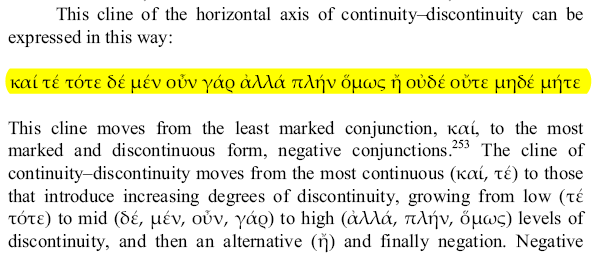Disclaimer: The post below refers the implementation of SFL in NT studies, which may or may not necessarily reflect Halliday’s intentions. My goal is to address the methodological and theoretical flaws of the approach to SFL popularized by Stanley Porter. There is reason to believe that it represents a departure from Hallidayan linguistics (10/2/09).
In my last post, I began to outline some of the inherent flaws that I have observed in the application Systemic Functional Linguistics (SFL) to Koine Greek. The post focused on the problems associated with representing language choices in a tree diagram. Although trees provide a very tidy and organized layout of possible choices facing a language user, they only allow one factor to be considered at a time. In other words, if it takes me three levels of a tree to outline the various choices involved in selecting a single form, the tree method does a poor job of modeling reality. In reality, most language choices look more like a matrix than a tree. I resolve to live in reality, not in the trees! Now, on to my next point.
The topic today, class, is clines. No, I am not talking about David J. A. Clines, but those that are used within various linguistic methodologies to represent various kinds of hierarchies. Clines are a very integral part of SFL applied to the GNT, and are often put to good use.
Concerning clines Reed states, “One of the more serviceable aspects of SFL for discourse analysis is the use of the cline (equals ‘scale’ or ‘continuum’) to describe linguistic phenomena”(Discourse Analysis of Philippians, 37) He goes on to state that linguistic elements rarely fall into one plain category or another, “but rather they fall on a cline on which the categories shade into one another”(Ibid., 38). Reed is applying this cline approach to cohesiveness, where indeed it provides a useful framework for describing how some factors result in greater cohesion or discontinuity than others.
Porter and O’Donnell use a cline to express the differing levels continuity signaled by Greek conjunctions. Here is an excerpt from the 2006 Proceedings of the LIABG, 152:

For the record, know that I am not against clines, or that I do not see their utility. On the contrary, I believe they are an effective means of expressing gradations. My fundamental disagreement with SFL lies with their implementation of a symmetrical view of markedness, whereby markedness claims are grounded in statistical frequency. I have laid out my own framework in a series of posts which I would encourage you to read. This background is crucial to understanding many of the clines presented within SFL lack the explanatory value they claim.
Introduction to markedness
Markedness, Part 2
Markedness, Part 3
Markedness and nesting
Markedness and patterns
My next post will deal with specific examples to prove my point.

[…] last post on clines described one of the benefits they provide in description. However, like all things, there is a […]
[…] groups them by kind of clause (primary, secondary, embedded), then ranks them using a classic SFL cline where the markedness or prominence of a particular order is inversely proportional to its […]